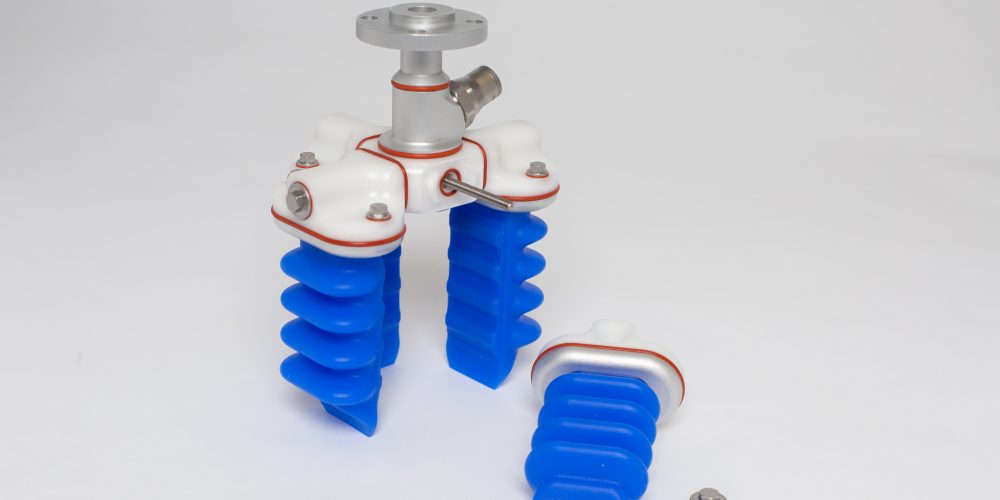Soft Robotics Grippers developed to open doorways and pull on heavy objects

A closed door is simply one of many obstacles that poses no barrier to a new kind of flying, micro, soft robotics grippers referred to as a FlyCroTug. It is equipped with advanced gripping technologies modeled after a gecko and has the ability to cross and pull on objects around it, two FlyCroTugs can jointly lasso the door take care of and heave the door open.
Developed in the labs of Mark Cutkosky, the Fletcher Jones Chair in the School of Engineering at Stanford University, and Dario Floreano at the École Polytechnique Fédérale de Lausanne in Switzerland, FlyCroTugs are micro air cars that the researchers have modified so the cars can anchor themselves to a range of surfaces the usage of adhesives stimulated by the ft of geckos and insects, earlier developed in Cutkosky’s lab.
CFE Media
With these attachment mechanisms, FlyCroTugs can pull objects up to forty instances their weight, like door handles in one scenario, or cameras and water bottles in a rescue situation. Similar cars can solely raise objects about twice their personal weight using aerodynamic forces.
“When you’re a small robot, the world is full of giant obstacles,” stated Matthew Estrada, a graduate scholar at Stanford and lead creator of a paper on FlyCroTugs. “Combining the aerodynamic forces of our aerial car along with interaction forces that we generate with the attachment mechanisms resulted in something that used to be very mobile, very forceful and micro as well.”
The researchers said the FlyCroTugs’ small measurement potential they can navigate thru snug spaces and pretty shut to people, making them beneficial for search and rescue. Holding tightly to surfaces as they tug, the tiny robots should doubtlessly move pieces of debris or function a digicam to consider a treacherous area.
Taking a cue from nature
As with most tasks in Cutkosky’s lab, the FlyCroTugs were inspired via the herbal world. Hoping to have an air car that used to be fast, small and surprisingly maneuverable however also able to move large loads, the researchers appeared to wasps.
“Wasps can fly rapidly to a piece of food, and then if the thing’s too heavy to take off with, they drag it alongside the ground. So this was once type of the opening proposal for the approach we took,” Cutkosky said, who is a co-author on the paper.
The researchers study research on wasp prey seize and transport, which discover the ratio of flight-related muscle to whole mass that determines whether or not a wasp flies with its prey or drags it. They also observed the lead of the wasp in having exceptional attachment options depending on the place the FlyCroTugs land.
The tiny robots may want to doubtlessly move pieces of particles or position a digicam to evaluate a treacherous area. Courtesy: Kurt Hickman, Stanford University
The tiny robots may want to doubtlessly pass pieces of debris or function a digital camera to consider a treacherous area. Courtesy: Kurt Hickman, Stanford University
For clean surfaces, the robots have gecko grippers. They are non-sticky adhesives that mimic a gecko’s elaborate toe structures and maintain on by growing intermolecular forces between the adhesive and the surface. For rough surfaces, these robots are geared up with 32 microspines, a series of fishhook-like metallic spines that can in my opinion latch onto small pits in a surface.
Each FlyCroTug has a winch with a cable and both microspines or gecko adhesive in order to tug. Beyond those fixed features they are in any other case incredibly modifiable. The region of the grippers can vary depending on the floor where they will be landing, and the researchers can additionally add parts for ground-based movement, such as wheels. Getting all of these aspects onto a small air vehicle with twice the weight of a golf ball was once no small feat, according to the researchers.
“People tend to assume of drones as machines that fly and observe the world, however flying bugs do many different matters — such as walking, climbing, grasping, building — and social insects can even cooperate to multiply forces,” stated Floreano, who was senior creator on the paper. “With this work, we show that small drones capable of anchoring to the surroundings and participating with fellow drones can perform duties normally assigned to humanoid robots or plenty large machines.”
Interacting with the world
Drones and different small flying robots can also seem like all the rage these days but the FlyCroTugs — with their capability to navigate to far flung locations, anchor and pull — fall into a more precise niche, in accordance to Cutkosky.
“There are many laboratories around the world that are starting to work with small drones or air vehicles, however if you appear at the ones that are also wondering about how these little automobiles can have interaction physically with the world, it’s a lots smaller set,” he said.